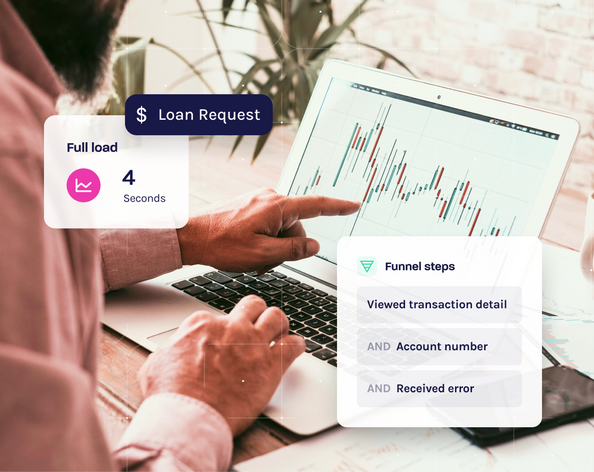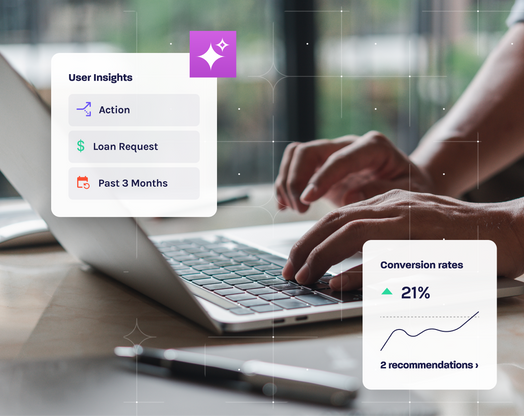
What's Transaction Monitoring and How Does it Work?
Keeping pace with digital transactions means more than simply moving money from point A to point B. You need a process that reviews every payment in real time, flags unusual patterns and equips your teams to act before fraudsters or non-compliant activity slip through the cracks. That process is transaction monitoring, and it sits at the heart of effective anti-money-laundering (AML) and fraud-prevention programs.
Modern monitoring combines real-time data collection, dynamic rule sets, escalating alerts and filing Suspicious Activity Reports (SARs) to help financial institutions stay compliant. Core capabilities like behavioral analytics, instant detection and audit-ready reporting are essential tools for navigating today’s tightening regulatory landscape. Yet, many institutions still face hurdles with legacy systems, which lack the agility to adapt to new threats or customer behavior patterns. That’s where digital experience analytics is helpful. Behavioral insights can sharpen decision-making at every stage of the customer journey.
Curious how a platform can capture subtle user behavior and enrich transaction data? Advanced digital conduct monitoring tools make it possible to spot risk earlier, comply with global standards and deliver secure, seamless digital banking experiences. Teams gain visibility into user actions and intent—insights that traditional systems often miss. For more on behavior-centric oversight, explore our guide on how digital conduct monitoring helps protect both institutions and their customers.
What Is Transaction Monitoring?
At its core, transaction monitoring is the continuous, real-time review of customer transactions—deposits, withdrawals, transfers and payments—to uncover suspicious activity before it damages your institution or its customers. By applying analytics and rules to live transaction data, you can detect red flags such as structuring, sudden spikes in wire amounts or transfers to high-risk jurisdictions. This discipline underpins AML compliance and broader fraud detection strategies, helping you satisfy regulators while protecting revenue.
In practice, monitoring extends well beyond a simple ledger scan. Modern systems ingest transaction amounts, counterparties, geolocations and device details, then compare every event to expected customer behavior. When anomalies arise, alerts prompt analysts to investigate and, when necessary, file a SAR. The payoff is twofold: you meet obligations under laws like the Bank Secrecy Act and you reduce financial loss from fraudulent transactions.
How does this differ from adjacent controls? It helps to distinguish transaction monitoring from two related practices:
Transaction screening checks individual payments against watchlists such as the Office of Foreign Assets Control or local sanctions registers before a transfer is executed
Identity verification, or Know Your Customer (KYC) confirms a customer’s legitimacy at onboarding and during periodic reviews
Monitoring complements these steps by surveilling ongoing customer activity, which can catch risks that screening or KYC might miss once an account is active.
Financial professionals often ask two common questions:
Do banks monitor transactions?
Yes. Every regulated financial institution must monitor customer transactions under AML and counter-terrorist financing rules. Banks deploy transaction monitoring software that applies risk-based scenarios and machine learning to spot unusual patterns. Failure to maintain an effective program can lead to multimillion-dollar fines, consent orders and reputational harm.
What is a transaction monitoring system?
A transaction monitoring system is a technology platform that collects transaction data, applies rule-based or AI-driven analytics, generates alerts, supports case management and produces audit trails for regulators. Leading platforms integrate with core banking systems, card processors and digital channels to provide unified oversight across web, mobile and in-branch interactions. Key capabilities include real-time alerting, customizable transaction monitoring rules, customer risk profiling and automated SAR report creation.
By understanding these fundamentals, you can lay the groundwork for evaluating whether your current monitoring approach is ready for fast-evolving fraud tactics and stricter regulatory scrutiny.
Why Transaction Monitoring Matters in Financial Services
In banking, fintech and insurance, every transaction is a potential entry point for money laundering, account takeover or sophisticated fraud. Effective transaction monitoring using financial services solutions that use the first line of defense enables you to spot irregularities before they escalate into financial loss or regulatory trouble.
Financial criminals constantly refine tactics—layering small transfers to obscure origins, hijacking dormant accounts or exploiting instant payment rails to whisk funds away in seconds. A strong financial services monitoring program cuts through that noise, flagging suspicious transaction patterns the moment they emerge and giving investigators the context needed to intervene.
Beyond protecting revenue, transaction monitoring is indispensable for AML compliance. Regulations such as the Bank Secrecy Act, the Financial Action Task Force (FATF) recommendations and the General Data Protection Regulation (GDPR) mandate that financial institutions maintain continuous oversight, file timely SARs and demonstrate a risk-based approach. Timely detection and prevention aren’t just best practices—they’re business imperatives:
Detecting money laundering early prevents criminals from legitimizing illicit funds.
Catching account takeovers safeguards customer trust and reduces charge-offs.
Identifying insider or cyber-enabled fraud protects balance sheets and brand reputation.
Demonstrating robust oversight satisfies regulators and avoids operational disruptions.
As digital channels gain ground, legacy monitoring tools struggle to keep pace with the volume and velocity of online transactions. Modern platforms must correlate data across web, mobile and back-office systems, layering behavioral analytics to reveal intent behind each click and transfer. This is why leading institutions are augmenting traditional rule engines with solutions like Glassbox for Financial Services—gaining real-time insight into user journeys and reducing false positives that drain analyst productivity.
A Step-by-Step Guide: How Transaction Monitoring Works
An effective monitoring lifecycle follows a clear sequence—collect, analyze, apply rules, escalate, report and refine—all while balancing automation, accuracy and regulatory compliance. The stages below illustrate how you can transform raw transaction data into actionable insight that protects customers and the institution.
1. Data Collection
The journey begins with comprehensive data capture. You ingest structured data points such as transaction amount, origin, destination, frequency and timestamp. To strengthen risk scoring, you merge these details with customer profiles that include onboarding risk ratings, geolocation and identity verification status. Finally, you overlay behavioral signals—device fingerprint, session duration, mouse movements or navigation patterns—which reveal intention and highlight anomalies invisible to purely monetary metrics. Equipped with this unified dataset, you are ready to examine behavior against history and peer groups as we explore next.
2. Transaction Analysis and Pattern Recognition
With data centralized, analytics engines compare each new transaction to historical norms. Spikes in transfer amounts, sudden shifts in geographic origin or an unusual flurry of logins outside business hours can all raise suspicion. Trend analysis surfaces deviations while journey-level review spots repeated failed payment attempts or suspicious multi-step sequences. These insights set the stage for the next layer of defense: codified monitoring rules.
3. Rule-Based Monitoring
Rules translate institutional risk appetite into action. You might flag cash deposits over $10,000, high-velocity small transfers or three consecutive failed logins tied to a single IP address. AML transaction monitoring rules are adjustable—tightened for high-risk segments, relaxed for low-risk regions—and can evolve dynamically as customer segments or jurisdictions change. Once rules are live, the system stands ready to escalate potential threats.
4. Alerts and Escalation
When a transaction breaches a threshold or matches a suspicious pattern, the monitoring system generates an alert. Prioritization logic ranks events by potential impact, ensuring that a six-figure wire to a sanctioned country outweighs a minor card dispute. Alerts route automatically to fraud, AML or risk teams, complete with contextual data and session history so investigators can act quickly. After review, truly suspicious cases move to formal reporting.
5. Suspicious Activity Reports (SARs)
For activity deemed reportable, analysts compile a SAR. The SAR documents transaction details, behavioral context and the analyst’s risk assessment, then follows a standardized workflow for internal approval and submission to the relevant regulatory authority. Combining digital behavior with transaction data strengthens narrative quality, making it easier for regulators to grasp intent. Once filed, the case record remains in the audit trail, supporting future inquiries and model tuning. The final consideration is timing—deciding whether insight arrives in the moment or after the fact.
6. Real-Time vs. Post-Transaction Monitoring
Real-time monitoring delivers immediate alerts, letting you halt or hold funds before loss occurs. Post-transaction analysis, on the other hand, uncovers complex fraud rings or laundering networks that reveal themselves only through retrospective pattern discovery. Glassbox enriches both approaches by injecting behavioral context through capabilities such as session replay, so teams can see exactly how users navigated the site or app before triggering an alert. Whether proactive or investigative, behavior-aware monitoring shortens response times and sharpens compliance.
Transaction Monitoring and Compliance
Regulators worldwide expect you to know your customers, understand their behavior and act swiftly when something looks amiss. Transaction monitoring is the mechanism that proves you’re meeting those expectations under frameworks like the Bank Secrecy Act, GDPR, FATF recommendations and region-specific AML directives. By maintaining a continuous watch over customer transactions, you demonstrate a risk-based approach, satisfy mandatory reporting timelines and protect the integrity of the global financial system.
However, the question often arises, “What exactly counts as a suspicious transaction?” Common red flags include transfers that exceed stated thresholds, unusual spikes in activity, round-number cash deposits, rapid fund movement through multiple accounts or transactions involving sanctioned geographies. Yet context is critical. A $15,000 wire from a low-risk corporate client with a history of similar transfers may be legitimate, whereas a $2,000 transfer from a newly opened personal account to a high-risk country could warrant escalation. Effective monitoring layers customer risk profiles and behavioral data onto these monetary events, clarifying whether a transaction is genuinely unusual or simply part of normal operations.
Auditability and transparency are non-negotiable. Regulators will ask to see how alerts were generated, which rules or models triggered them, who reviewed each case and why certain SARs were, or weren’t, filed. Modern monitoring systems store every decision point, comment and document in a tamper-evident trail. This level of documentation not only satisfies auditors but also helps you refine rules, reduce false positives and train new analysts.
Best practices in compliance echo these principles:
Adopt a risk-based approach, calibrating thresholds to customer profiles.
Integrate behavior analytics to distinguish intent and reduce alert fatigue.
Automate case management workflows to ensure timely SAR submission.
Conduct regular model validation and scenario tuning.
Keep documentation centralized, searchable and regulator-ready.
To see how behavior-aware analytics can streamline regulatory obligations, explore overviews of compliance solutions and perspectives on the future of compliance in complaints management and digital banking. Aligning transaction monitoring with these best practices mitigates regulatory risk and bolsters customer trust and operational resilience.
Challenges in Today’s Transaction Monitoring Landscape
Legacy monitoring tools were built for batch files, siloed systems and predictable payment patterns. Today, the digital economy looks starkly different. Below are the five major gaps many institutions face and why closing them requires a fresh, behavior-centric approach.
Fragmented Data Across Systems
Customer activity rarely stays on a single platform. Core banking records live on one server, card transactions flow through another and mobile app interactions sit in a separate analytics stack. When these data sources fail to communicate, analysts miss cross-channel clues that could reveal money laundering or fraudulent transactions. Disconnected datasets also complicate the creation of unified customer profiles, making it difficult to track a transaction pattern that spans web, mobile and branch visits. By stitching together omnichannel data streams, you’ll be ready to tackle the next obstacle: fast-moving digital fraud.
Rise of Digital-First Fraud Tactics
Criminals have pivoted to social engineering, automated bots and device spoofing, all of which can mimic legitimate user behavior at scale. A sophisticated bot can log in, initiate multiple low-value transfers and vanish in minutes, slipping past static velocity rules. Device obfuscation and IP masking further cloud detection efforts. Understanding these evolving methods is essential, yet rule-based engines alone often fall short, creating the problem of excessive false positives examined below.
False Positives From Static Rule Sets
Rules that fire on any cash deposit over $10,000 or every international wire may capture illicit behavior, but they also mislabel countless legitimate customer transactions. The result is alert fatigue, wasted analyst hours and occasionally missed real threats as teams sift through noise. Over time, regulators scrutinize institutions that drown in false positives yet overlook actual suspicious activity. Minimizing unnecessary alerts sets the stage for clearer insight across every touchpoint.
Limited Visibility Across Omnichannel Experiences
Customers glide between mobile, web and in-app channels without blinking, but legacy monitoring struggles to follow. Gaps appear at handoffs—like when starting a wire on a desktop and finishing it on a phone—allowing fraudulent transactions to hide in plain sight. Without a behavioral layer, institutions can’t determine whether a sudden abandonment in a loan application signals frustration, system error or attempted fraud. Recognizing this blind spot leads directly to the final challenge.
The Need for Behavior-Centric Analytics
Behavior is often the deciding factor between genuine and suspicious activity. Journey mapping, session replay and interaction analytics reveal intent—hesitation before confirming a high-value transfer, erratic mouse movements or copy-pasted account numbers can all hint at fraud. Combining these insights with traditional monitoring rules adds depth, reduces false positives and accelerates investigations. For an example of how user expectations continue to evolve—especially among younger demographics—see our take on Gen Z’s digital banking habits. Embracing behavior-aware monitoring fills existing gaps while also future-proofing your institution against the next wave of digital threats.
Optimizing Transaction Monitoring With Digital Analytics
Traditional monitoring flags monetary anomalies, but digital analytics exposes the intent behind them. By layering user-behavior insights onto transaction data, you sharpen detection accuracy, slash false positives and accelerate case resolution.
Digital Experience Monitoring for Behavioral Anomalies
Tracking every scroll, tap and click across web and mobile channels reveals subtle signals that pure transaction logs miss. Rage clicks, rapid back-and-forth navigation or sudden abandonment moments before submitting a transfer can indicate uncertainty, coercion or bot interference. Analyzing these interaction patterns helps you separate legitimate customers from fraudsters and prioritize alerts that truly matter, setting the stage for deeper investigation with visual evidence.
Session Replay for Investigative Context
When a transaction monitoring tool raises an alert, analysts need context fast. Session replay delivers a play-by-play view of the user journey leading up to the flagged transaction. You can see whether a customer carefully reviewed transfer details, accidentally double-clicked a submit button or if an automated script barreled through the page in milliseconds. This clarity speeds decisions, supports SAR narratives and strengthens audit readiness, making every investigation more efficient.
Funnel Analysis to Detect Suspicious Drop-Offs
High-value customer flows—loan applications, wire transfers, new account openings—are prime targets for fraud. Funnel analysis pinpoints where users frequently exit these journeys, then correlates drop-offs with unusual behavior or technical friction. A surge in abandonments at the payment-verification step, coupled with device spoofing signals, may indicate organized fraud attempts masked as normal churn. Identifying these patterns early preserves revenue and protects customer trust.
Real-Time Alerts Using AI and Pattern Recognition
AI-driven models refine alert thresholds on the fly, considering user risk level, historical behavior and peer benchmarks. Predictive analytics can flag a suspicious transaction seconds before it completes, giving teams the chance to halt funds or require additional verification. Dynamic thresholds also reduce dependency on rigid rules, cutting false positives and allowing analysts to focus on high-impact cases.
Combining Transaction and Journey Data for Holistic Insight
True visibility emerges when you cross-reference transaction amounts, counterparties and geolocation with session recordings, click paths and device fingerprints. This holistic view reveals whether a flagged transaction is part of a legitimate customer journey or an isolated, high-risk event. By merging these datasets, institutions see a measurable drop in alert fatigue, faster case closure and stronger regulatory confidence.
Key Features of Transaction Monitoring Systems
Every robust monitoring system rests on a core set of capabilities designed to detect suspicious activity quickly, prove compliance and keep workflows efficient.
Before exploring how behavior-aware analytics add depth, consider the foundational features that any effective platform should provide:
Real-time alerting that surfaces suspicious transactions as they occur, preventing fraudulent transactions from settling.
Custom rule engines that let you tailor transaction monitoring rules to institutional risk appetite, customer segments and regional regulations.
Customer risk profiling that adjusts thresholds and scenarios based on a client’s history, geography, KYC data and transaction pattern.
Pattern-based detection that applies machine learning or statistical models to uncover complex money laundering tactics and hidden fraud rings.
Audit trails and reporting that log every decision, alert, investigation note and SAR—providing regulators with end-to-end transparency.
These features deliver solid coverage, yet traditional systems often overlook a crucial layer: the digital behavior leading up to each flagged transaction. That’s where Glassbox steps in.
Glassbox augments existing monitoring software by capturing every web, mobile and hybrid interaction—session duration, navigation paths, tap patterns and device fingerprints—and linking those insights directly to transaction data. Analysts gain immediate clarity into questions like: Did the user hesitate before submitting a $50,000 wire? Was a bot responsible for rapid-fire account changes? Did technical friction prompt an unusual retry pattern mistaken for fraud?
Adding behavior-based context fills gaps that static rule engines miss, reduces false positives and speeds investigations. This digital conduct strategy also surfaces friction points that may be costing you legitimate revenue, turning compliance insight into customer experience improvements. In short, pairing traditional monitoring features with Glassbox’s digital analytics delivers a 360-degree view of customer activity that keeps regulators satisfied and customers secure.
Get Started With Transaction Monitoring
Continuous monitoring is no longer optional, it’s the backbone of fraud prevention and regulatory compliance. By enriching transaction data with real-time behavioral insights, Glassbox equips your teams to detect risk sooner, investigate faster and protect customers across every digital touchpoint.
Glassbox works as an overlay to your existing AML infrastructure, adding a layer of visibility that traditional monitoring systems don’t offer. Whether your banking experience is web-first, mobile-only or a hybrid of both, lightweight software development kits and tagless capture make implementation straightforward. Once live, analysts can watch session replays, correlate journey data with flagged transactions and fine-tune alert thresholds based on actual user behavior, which reduces false positives without loosening controls.
Ready to see how behavior-centric monitoring elevates compliance and customer trust? Take the platform tour and discover the difference firsthand.







